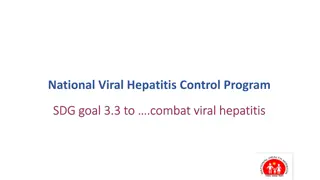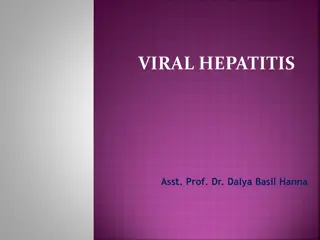Elimination of Hepatitis C in Individuals With HIV Infection
Discussing the goals, treatment options, and global impact of Hepatitis C in individuals with HIV infection, this presentation by Dr. David L. Thomas from Johns Hopkins Medical Institutions sheds light on important aspects such as mortality projections, WHO elimination goals, and targets for hepatitis C intervention. The content also includes interactive questions related to the future outlook of chronic HCV and HBV mortality. Dr. Thomas has no relevant financial affiliations to disclose.
Download Presentation

Please find below an Image/Link to download the presentation.
The content on the website is provided AS IS for your information and personal use only. It may not be sold, licensed, or shared on other websites without obtaining consent from the author.If you encounter any issues during the download, it is possible that the publisher has removed the file from their server.
You are allowed to download the files provided on this website for personal or commercial use, subject to the condition that they are used lawfully. All files are the property of their respective owners.
The content on the website is provided AS IS for your information and personal use only. It may not be sold, licensed, or shared on other websites without obtaining consent from the author.
E N D
Presentation Transcript
Elimination of Hepatitis C in Individuals With HIV Infection David L. Thomas, MD, MPH Professor of Medicine The Johns Hopkins Medical Institutions Baltimore, Maryland
Financial Relationships With Commercial Entities Dr Thomas has no relevant financial affiliations to disclose. (Updated 11/12/18)
Learning Objectives After attending this presentation, learners will be able to: List two 2030 elimination goals for HCV infection Compare treatment of HCV infection in a person with HIV infection and someone without
ARS Question 1: Which is most true about the expected future (2040) mortality from chronic HCV and HBV? 1. Should decrease in parallel with HIV 2. Will exceed HIV 3. Will exceed TB 4. Will exceed malaria 5. Will exceed HIV+TB+malaria
ARS Question 1: Which is most true about the expected future (2040) mortality from chronic HCV and HBV? 1. Should decrease in parallel with HIV 2. Will exceed HIV 3. Will exceed TB 4. Will exceed malaria 5. Will exceed HIV+TB+malaria
Global health importance of hepatitis Foreman Lancet 2018; IHME, 2015 http://ghdx.healthdata.org
WHO Hepatitis Elimination Goals 90% reduction in incidence 2015 2020 (30%) 2030 ~1.75 million ~1.23 million 175,000 HCV WHO Global Hepatitis Report 2017
WHO Hepatitis Elimination Goals 65% reduction in mortality 2015 2020 (10%) 2030 ~400,000 ~360,000 140,000 HCV WHO Global Hepatitis Report 2017
Targets to eliminate hepatitis C Intervention 2015 2020 2030 HCV diagnosed 20% 30% 90% HCV treatment 1% 3 million 80% Donations screened 97% 97.5% 100% Harm reduction (syr/person/yr) 27 200 300 Safe injection 95% 100% 100% WHO Global Hepatitis Report 2017
Global cascade of HCV care and 2030 WHO elimination goals: 90/80 target 2015 Reality 2030 Target 80 Number worldwide (millions) 70 60 50 40 30 20 10 0 Infected Diagnosed Treated Cured WHO Global Hep Report 2017
Elimination prefix cascade Eradication Elimination Micro- elimination HIV positive Nano- elimination National Pico- Clinic elimination Patient
ARS Question 2: A 53 year old man with 1a HCV and HIV on r/DRV, FTC, and TDF with F1-2 disease presents for HCV treatment. Which is true? 1. Needs 24 weeks of treatment due to HIV 2. Doesn t need treatment due to low F score 3. Change ART first 4. Add ribavirin to regimen 5. Must screen for HCC before starting
ARS Question 2: A 53 year old man with 1a HCV and HIV on r/DRV, FTC, and TDF with F1-2 disease presents for HCV treatment. Which is true? 1. Needs 24 weeks of treatment due to HIV 2. Doesn t need treatment due to low F score 3. Change ART first 4. Add ribavirin to regimen 5. Must screen for HCC before starting
Efficacy of SOF/LDV in HIV Co-infected patients 100 97 96 96 95 335 patients SOF/LDV x 12 wk 82% male, 34% AA, 98% geno 1 55% experienced 20% cirrhosis All 10 relapses were in AA 8/10 on EFV 80 94 SVR12 (%) 60 40 20 0 Naggie S. NEJM 2015.
Efficacy of SOF/VEL in HIV/HCV Coinfection 106 patients SOF/VEL x 12 wks 86% male 45% AA 18% cirrhosis 62% GT1a, 11% GT3 SVR cirrhosis: 19/19 (100%) SVR treatment-experienced: 29/31 (94%) 95 95 92 100 92 100 100 Patients With 80 SVR12, % 60 2 Relapse 1 LTFU 1 Withdrew Consent 1 LTFU 40 20 101 106 63 66 11 12 11 11 11 12 5 5 0 Total 1a 2b 2 3 4 Wyles CID 2017
Efficacy of GLE/PIB in HIV/HCV Coinfection 150 patients G/P x 8 or 12 wks 18% Black 19% TE 16% GT3 88% F0-F1 SVR: 93% SVR in cirrhosis (14/15) 1 breakthrough GT3 cirrhosis 98 99 100 80 Patients With SVR12, % 60 40 20 150 153 150 151 0 SVR12 ITT mITT Noninferiority Threshold Rockstroh CID 2018
GLE/PIB for 8 weeks works well in cirrhosis 280 patients G/P x 8 wks 10% Black Treatment naive Compensated cirrhosis NO HIV 60 Genotype 3 + cirrhosis not yet known 150 153 150 151 Brown AASLD 2018
Efficacy of elbasvir/grazoprevir in HIV Co-infection 218 patients ELB/GRA x 12 wks 175 male 38 African American 35 cirrhosis 164 on TDF containing Rockstroh Lancet HIV 2015
Treatment of HCV in HIV/HCV Coinfection 100 99 98 97 96 95 95 95 100 Patients With SVR12, % 90 80 70 60 50 40 30 20 10 0 SOF/VEL ELB/GRZ LDV/SOF GLE/PIB 1 2 3 4 HIV/HCV HCV Composite slide adapted from Naggie S, Duke University. 1. Wyles D, et al. Clin Infect Dis. 2017;65(1):6-12; 2. Rockstroh JK, et al. Lancet HIV. 2015;2(8):e319-327; 3. Naggie S, et al. N Engl J Med. 2015;373(8):705-713; 4. Rockstroh JK, et al. European Association for the Study of the Liver (EASL) The International Liver Congress 2017. April 19 23, 2017; Amsterdam, the Netherlands. Abstract LB-522.
Cure of HCV in HIV-infected reduces ESLD and HCC Limketkai JAMA 2012; Berenguer Hepatol 2009; Merchante J Antimicrobiol Ther 2018
HCV Care Continuum among 594 HIV/HCV infected patients in an urban HIV clinic Chronic HCV Referred Evaluated Prescribed Initiated Cured Reinfected 594 547 517 457 426 374 5
Elimination of HCV in HIV infected in Netherlands Athena cohort >98% of HIV pos in recognized in Netherlands 69% MSM, 15% PWID DAAs made available in 2015 15 months of data through Feb 2017 Boerekamps CID 2018
Elimination of HCV in HIV infected in Netherlands Boerekamps CID 2018
Elimination of HCV in HIV infected in Netherlands Boerekamps CID 2018
Elimination of HCV in HIV infected persons in France Cotte CROI 2018
ARS Question 3: How many HCV infected people need to be cured to eradicate HCV from HIV-infected population? 1. 20,000 2. 200,000 3. 2,000,000 4. 20,000,000
ARS Question 3: How many HCV infected people need to be cured to eradicate HCV from HIV-infected population? 1. 20,000 2. 200,000 3. 2,000,000 4. 20,000,000
2.27 million persons are HIV/HCV coinfected Platt Lancet ID 2016
Eradication Elimination prognosis? Elimination Micro- elimination HIV positive Nano- elimination National Pico- Your patients elimination
Eradication Elimination prognosis? Elimination Micro- elimination HIV positive Nano- elimination National Pico- Your patients elimination
Public health response to eliminate HCV Requires shifting to public health response HIV example ART given to >20 million persons (>240 million person months)/year Cost of HIV ~20 billion USD/year Can build on HIV infrastructure for HIV/HCV elimination 2 million/2-3 months each <6 million person months TOTAL Must avoid 2040 forecast for status quo
Thanks! JHU HIV WHO Mark Sulkowski Seun Falade-Nwulia Kathleen Ward Richard Moore Shruti Mehta Yvan Hutin Godfrey John Ward HCV/HIV David Wyles Susanna Naggie
WHO elimination indicators and targets WHO Global Hepatitis Report 2017
WHO goals for elimination of hepatitis C A world where viral hepatitis transmission is stopped and everyone has access to safe, affordable and effective treatment and care WHO Elimination: Reduction to zero of the incidence of infection caused by a specific agent in a defined geographical area as a result of deliberate efforts; continued measures to prevent re- establishment of transmission are required. Example: measles, poliomyelitis. WHO Global Hepatitis Report 2017; Hill J Virus Elimin 2016
HCV could be eradicated Every HCV-infected person can be detected Eradicate infection by treatment Humans are only source Transmission can be prevented Public health importance
HCV could be eradicated Every HCV-infected person can be detected Eradicate infection by treatment Humans are only source Transmission can be prevented Public health importance International commitment























